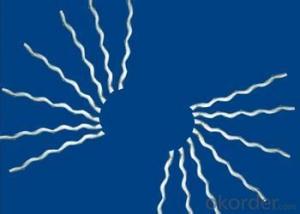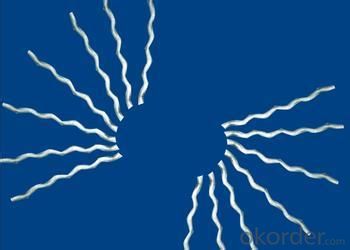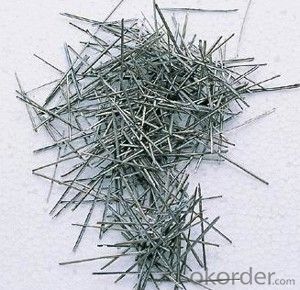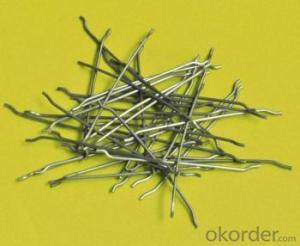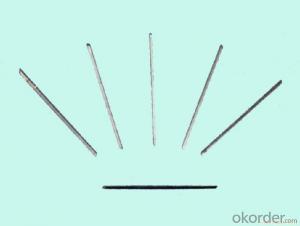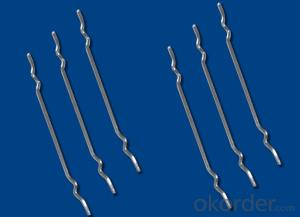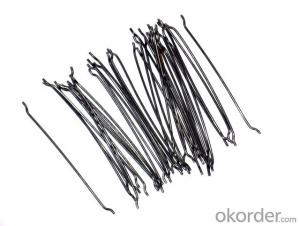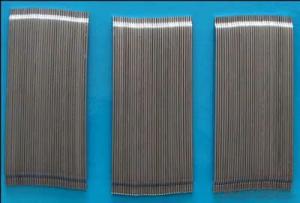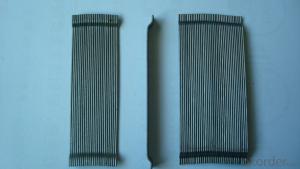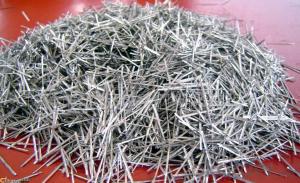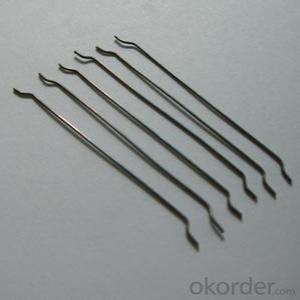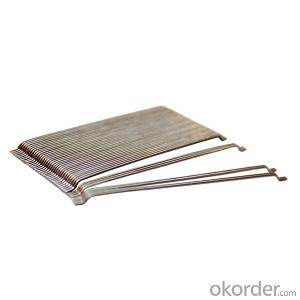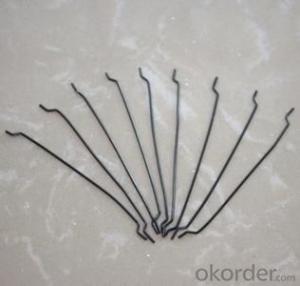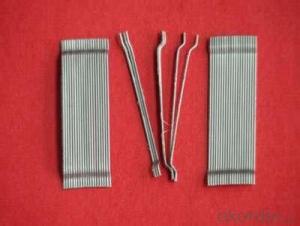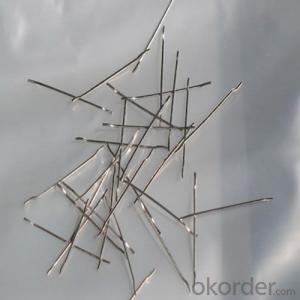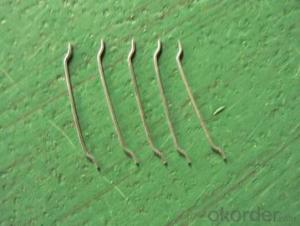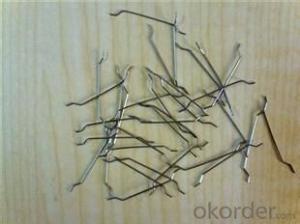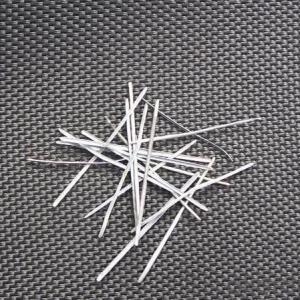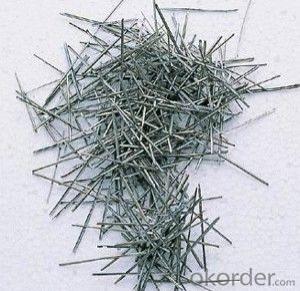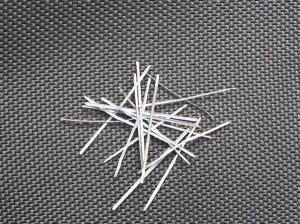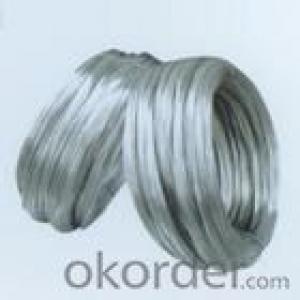Melt Extract Stainless Steel Fiber End Hook Glued Steel Fiber from CNBM China
- Loading Port:
- Tianjin
- Payment Terms:
- TT OR LC
- Min Order Qty:
- 1 m.t.
- Supply Capability:
- 600 m.t./month
OKorder Service Pledge
Quality Product, Order Online Tracking, Timely Delivery
OKorder Financial Service
Credit Rating, Credit Services, Credit Purchasing
You Might Also Like
Quick Details
Place of Origin: Tianjin, China (Mainland)
Model Number: 0.50 mm
Material: Steel
Production Process: Cold drawn
Lengh: 35
Type: 1
Compressive Strength: >1200MPa
Aspect ratio: 70
Standard: ASTM A820M-11
Section Shape: Circular
Application: Concrete Reinforcement
Packaging & Delivery
| Packaging Details: | 20 kg/Bag,50 bags/Pallet or 1,000kg/ Bulk Bag |
|---|---|
| Delivery Detail: | 1 Month |
Product Description
| Diameter | 0.50 mm | ||
| Length | 35 mm | ||
| Aspect Ratio | 70 | ||
| Tensile strength | 1200 MPa | ||
| Type | Cold drawn Steel Fiber | ||
| End | Hooked-end Steel Fiber | ||
| Glued/Loose | Glued Steel Fiber | ||
| Bending Angle | 45°(min.30°) | ||
| Usage & Performance | Floor:Trafficked areas and Industrial floors | ||
| Shotcrete :Slope stabilization and Final lining | |||
| Precast concrete:Pipe and Railway sleepers | |||
| Packing | Standard Export Pallet Packing | Bag Packing | 20 kg/Bag,50 bags/Pallet |
| Bulk Packing | 1,000kg/ Bulk Bag | ||
| Loading Quantity | 20’GP | 20-25 Tonne/Tonnes | |
| 40’GP | 25-27 Tonne/Tonnes | ||
| 40’HQ | 25-27 Tonne/Tonnes | ||
| MOQ | 1 kg for trial order | ||
| Supply Ability | 10,000 Tonne/Tonnes per Year | ||
| Payment Terms | T/T or L/C at sight | ||
| Delivery Time | Within 15 days after receiving deposit or original L/C at sight | ||
| Certification | ISO9001:2000, CE, | ||
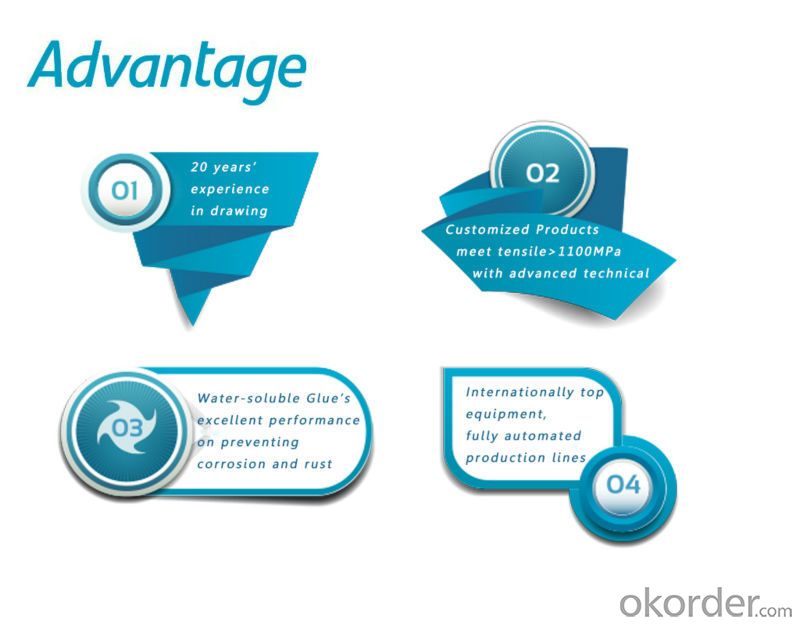
| Product | Diameter (mm) | Length (mm) | Aspect Ratio | Type | Packing |
| G-6030 | 0.5 | 30 | 60 | Glued | 20 kg/Bag, or 1,000kg/ Bulk Bag |
| G-6535 | 0.55 | 35 | 65 | Glued | 20 kg/Bag, or 1,000kg/ Bulk Bag |
| G-6035 | 0.6 | 35 | 60 | Glued | 20 kg/Bag, or 1,000kg/ Bulk Bag |
| G-8060 | 0.75 | 60 | 80 | Glued | 20 kg/Bag, 50 bags/Pallet |
| G-6060 | 0.9 | 60 | 60 | Glued | 20 kg/Bag, 50 bags/Pallet |
| G-6030 | 0.5 | 30 | 60 | Loose | 20 kg/Bag, or 1,000kg/ Bulk Bag |
| G-6535 | 0.55 | 35 | 65 | Loose | 20 kg/Bag, or 1,000kg/ Bulk Bag |
| G-6035 | 0.6 | 35 | 60 | Loose | 20 kg/Bag, or 1,000kg/ Bulk Bag |
| G-8060 | 0.75 | 60 | 80 | Loose | 20 kg/Bag, 50 bags/Pallet |
| G-6060 | 0.9 | 60 | 60 | Loose | 20 kg/Bag, 50 bags/Pallet |
- Q: Can melt extract stainless steel fiber be used in marine or coastal structures?
- Indeed, melt extract stainless steel fiber is applicable in marine or coastal structures. Stainless steel is renowned for its exceptional resistance to corrosion, rendering it a prime selection for structures continuously subjected to moisture and saltwater. The melt extract procedure additionally augments the fiber's ability to resist corrosion, thereby guaranteeing its longevity in marine or coastal settings. Moreover, stainless steel fibers possess substantial tensile strength and can bolster the concrete's structural integrity, rendering them appropriate for employment in diverse marine or coastal structures such as seawalls, piers, and offshore platforms.
- Q: Are there any limitations or precautions to consider when using melt extract stainless steel fiber?
- When using melt extract stainless steel fiber, there are certain limitations and precautions that need to be taken into account. To begin with, it should be noted that this type of fiber is not suitable for high-temperature applications. Its melting point is relatively low compared to other stainless steel alloys, meaning it may not be able to withstand extremely high temperatures without deforming or losing its structural integrity. Therefore, it is crucial to determine the maximum temperature the fiber can handle and avoid exposing it to temperatures beyond this limit. Another factor to consider is the possibility of corrosion. Although stainless steel is generally resistant to corrosion, certain environmental conditions, such as exposure to acids or chlorides, can still lead to corrosion. It is advisable to evaluate the specific corrosive agents present in the application environment and choose a stainless steel fiber grade that offers appropriate corrosion resistance. Additionally, proper handling and installation of the melt extract stainless steel fiber is important. The fibers can be sharp and pose a risk of injury if not handled correctly. It is recommended to wear gloves and other protective equipment while handling them to minimize the risk of cuts or abrasions. Furthermore, achieving the desired performance of the stainless steel fibers within a matrix material, such as concrete or composite, depends on their dispersion. It is necessary to ensure that the fibers are mixed and distributed properly to avoid clumping or agglomeration, which can result in uneven reinforcement and compromised mechanical properties. Lastly, the cost of melt extract stainless steel fiber should be taken into consideration. Compared to other options for fiber reinforcement, such as synthetic fibers or traditional steel rebars, stainless steel fiber can be more expensive. Therefore, it is important to assess the project budget and weigh the benefits of using stainless steel fiber against its higher cost. In conclusion, while melt extract stainless steel fiber offers several advantages, it is essential to be aware of its limitations and take necessary precautions. Understanding the temperature limits, potential for corrosion, handling requirements, dispersion considerations, and cost implications will help ensure the successful and safe use of this reinforcement material.
- Q: What is the typical fiber length of melt extract stainless steel fiber?
- The typical fiber length of melt extract stainless steel fiber is usually between 0.5 to 2 inches.
- Q: Can melt extract stainless steel fiber be used in hydraulic structure construction?
- Melt extract stainless steel fiber is indeed applicable in the construction of hydraulic structures. With its enhanced durability and resistance to corrosion, stainless steel fiber proves to be suitable for use in hydraulic structures that come into contact with water and other corrosive elements. Its versatility allows for its application in various areas, such as slabs, tunnel linings, and foundations, to improve the strength of structures and resistance against cracks. Moreover, the use of stainless steel fiber can also enhance the concrete's ductility and toughness, resulting in a better ability to withstand impact and seismic forces. Hence, melt extract stainless steel fiber serves as a feasible choice to reinforce hydraulic structures, ensuring their long-term stability and performance.
- Q: Can melt extract stainless steel fiber be used in parking garage construction?
- Yes, melt extract stainless steel fiber can be used in parking garage construction. Stainless steel fibers are commonly used in concrete to improve its structural performance and durability. They can help enhance the tensile and flexural strength of the concrete, reduce cracking and shrinkage, and increase resistance to corrosion and abrasion. In parking garages, where heavy loads, vehicle traffic, and exposure to moisture and chemicals are common, the use of stainless steel fibers can significantly improve the longevity and performance of the concrete. Additionally, stainless steel fibers can also enhance the fire resistance of concrete, making them suitable for parking garages where fire safety is crucial. Overall, melt extract stainless steel fiber is a suitable and effective reinforcement material for parking garage construction.
- Q: Can melt extract stainless steel fiber be used in lightweight concrete blocks or panels?
- Yes, melt extract stainless steel fiber can be used in lightweight concrete blocks or panels. The addition of stainless steel fibers enhances the strength and durability of the concrete, making it suitable for use in various construction applications.
- Q: Can melt extract stainless steel fiber be easily dispersed in concrete mixtures?
- Yes, melt extract stainless steel fiber can be easily dispersed in concrete mixtures. The fibers are typically added during the mixing process and can be evenly distributed throughout the mixture, enhancing the strength and durability of the concrete.
- Q: How does the addition of melt extract stainless steel fiber affect the drying time of concrete?
- The drying time of concrete can be significantly impacted by the inclusion of melt extract stainless steel fiber. Concrete mixtures often incorporate stainless steel fibers to improve durability and enhance mechanical properties. One notable advantage of using stainless steel fibers is their ability to reduce drying shrinkage. As concrete dries, it typically undergoes shrinkage, which can result in cracks and structural problems. However, the addition of stainless steel fibers helps to restrain this shrinkage, resulting in a more controlled and uniform drying process. The presence of stainless steel fibers also promotes the formation of a more interconnected network within the concrete matrix. This network enhances the concrete's resistance to cracking and strengthens it overall. Consequently, the concrete can better withstand forces and stresses, even during the drying phase. Moreover, stainless steel fibers also aid in reducing plastic shrinkage cracking. This type of cracking occurs during the early stages of concrete drying, when the surface moisture evaporates faster than it can be replaced. By reinforcing the concrete, the stainless steel fibers help to mitigate this cracking, leading to a more efficient and stable drying process. In conclusion, the addition of melt extract stainless steel fiber can have a significant impact on the drying time of concrete. By reducing drying shrinkage, enhancing mechanical properties, and mitigating cracking, these fibers contribute to a more controlled and efficient drying process. This ultimately improves the overall performance and durability of the concrete structure.
- Q: What is the effect of melt extract stainless steel fiber on the ductility of concrete?
- The addition of melt extract stainless steel fiber to concrete can have a positive effect on its ductility. Stainless steel fibers are known for their high tensile strength and excellent corrosion resistance, which can enhance the overall performance of concrete. When stainless steel fibers are added to concrete, they act as reinforcement, providing additional strength and stability to the material. This reinforcement helps to distribute stress and load more evenly throughout the concrete, thereby reducing the risk of cracking and increasing its ductility. Concrete with melt extract stainless steel fiber exhibits improved flexural strength, toughness, and resistance to impact and fatigue. The fibers act as a network within the concrete matrix, effectively bridging cracks and preventing their propagation. This bridging effect enhances the overall ductility of the concrete, allowing it to withstand greater deformation and maintain its structural integrity under various loading conditions. Furthermore, the corrosion resistance of stainless steel fibers ensures that they maintain their mechanical properties over time. This long-term durability contributes to the sustained ductility of the concrete, even in harsh environmental conditions or exposure to aggressive chemicals. Overall, the addition of melt extract stainless steel fiber to concrete can significantly enhance its ductility by providing reinforcement, improving crack resistance, and ensuring long-term durability. This improvement in ductility allows the concrete to better withstand external forces and maintain its structural integrity, making it a valuable addition to construction projects that require high-performance and durable concrete structures.
- Q: What is the effect of melt extract stainless steel fiber on the toughness of concrete?
- The addition of melt extract stainless steel fiber to concrete can have a positive effect on its toughness. Stainless steel fibers are typically used as reinforcement in concrete to enhance its mechanical properties, including toughness. When incorporated into concrete, these fibers act as tiny reinforcements, helping to distribute stress and prevent cracking. This reinforcement improves the overall toughness of the concrete, making it more resistant to impacts, vibrations, and other external forces. The melt extract stainless steel fibers are particularly effective in enhancing toughness due to their superior strength and durability. They are resistant to corrosion, which ensures their long-term effectiveness in concrete structures. Additionally, their small size and high aspect ratio allow for a better bond between the fibers and the surrounding matrix, further improving the overall toughness of the concrete. Overall, the addition of melt extract stainless steel fiber to concrete leads to an increase in its toughness, making it more resilient and durable. This can be particularly beneficial in applications where concrete is subjected to heavy loads, dynamic forces, or harsh environmental conditions.
Send your message to us
Melt Extract Stainless Steel Fiber End Hook Glued Steel Fiber from CNBM China
- Loading Port:
- Tianjin
- Payment Terms:
- TT OR LC
- Min Order Qty:
- 1 m.t.
- Supply Capability:
- 600 m.t./month
OKorder Service Pledge
Quality Product, Order Online Tracking, Timely Delivery
OKorder Financial Service
Credit Rating, Credit Services, Credit Purchasing
Similar products
Hot products
Hot Searches
Related keywords
